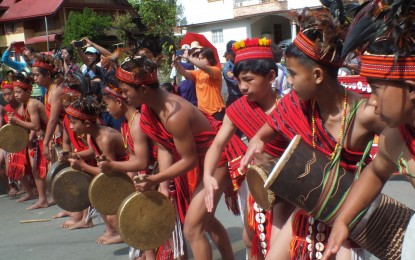
NATIVE ATTIRE. Young male dancers wearing the “bahag” perform during the 2018 Imbayah festival in Banaue, Ifugao. The NCIP-Cordillera and Benguet’s provincial government are seeking a probe into the misuse of the men's bahag and the women's tapis in a recent theater performance, where they were interchangeably worn by male and female performers, which is considered a cultural taboo. (PNA file photo by Liza Agoot)
LA TRINIDAD, Benguet – An official of the National Commission on Indigenous Peoples (NCIP) and the provincial government of Benguet have called for an investigation into the alleged misuse of the native attire in theater performances and by the police in the Ilocos region.
"We are asking for an investigation of the incident so that we would know the whole story behind the use of the bahag (G-string) by the ladies and the tapis (wrap-around skirt) by the men during a theater play and by the police in a special occasion," Gaspar Cayat, NCIP commissioner for the Ilocos and Cordillera regions, said in a phone interview on Tuesday.
He said Benguet’s provincial board had also approved a resolution during its October 24 session, seeking an investigation into the incident.
Several sectors in the Cordillera called out the misuse of the men's bahag and women's tapis in a recent performance at the Metropolitan Theater showing the attire being interchangeably used by male and female performers.
Cayat said they are awaiting the position of the National Commission on Culture and the Arts, which they would add to their stand on the issue.
He also said they have directed the regional and provincial offices, as well as the IP community action officers, to come up with a recommendation based on their investigation and meet with the different tribes in their areas to find out their stand on the incident.
“We want to know if this is allowed or not by the IP elders. Let us bring it back to the Indigenous Peoples political structure or the tribal elders who will decide for the tribe. It is the individual IP group that should react and give a recommendation or give a punishment if needed, correct if required,” he said.
Cayat noted that with western modernization and influence, there is now the issue of LGBTQ (lesbian, gay, bisexual, transgender, and queer or questioning) where the man wants to wear the tapis and the woman wants to wear the bahag.
“These issues are coming out and the elders might be open-minded to the idea of the LGBTQ who may not see anything wrong with it. In the NCIP, we should be culturally sensitive on this issue but we want a full investigation so that we can get the correct incident and make the appropriate decision,” he said.
On Monday, NCIP-Cordillera Director Atanacio Addog said the innovation on wearing traditional attires must follow the perspective of the IPs.
The issue is on the agenda of the regional summit of the Indigenous Peoples Mandatory Representative (IPMR) in Baguio on Thursday.
Addog said it was learned that the G-string used was of the woven fabric of the Ifugao.
“Dadating ang mga IPMR ng Ifugao for the summit but it is not just the Ifugaos but a collective action of the traditional leaders in (the Cordillera region) to avoid a possible repeat of the incident. These (bahag and tapis) are not mere garments but they represent the Indigenous Peoples, their cultures and tradition. So whenever we draw inspiration from them, we should ensure that the information we are conveying to the public is true and correct," he said.
Meanwhile, lawyer Josh Nalliw, a former IPMR in the municipality of Mayoyao, said being artistic "has boundaries."
The use of these garments, she said, must follow the IPs' customs and traditions. (PNA)
